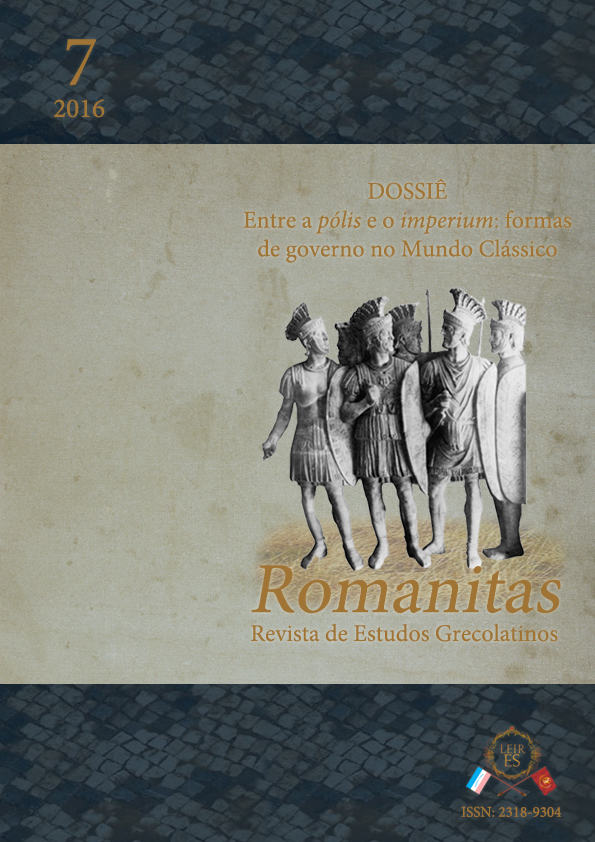Association to power: 'adoptio' and 'heredity' in the Tetrarchy government of Diocletian
DOI:
https://doi.org/10.17648/rom.v0i7.14523Keywords:
Late Roman Empire, Imperial succession, Tetrarchy, DiocletianAbstract
When he came to power through military acclamation in 284 AD, Diocletian faced a delicate situation: to restore the order in the Roman world affected since 235 AD by numerous civil wars, caused by disputes over the imperial power. Looking for the end of this cycle of political instability caused mainly by usurpations, he promoted the restructuring of the imperial system through the partition of power in four holders. The purpose of this article is to analyze the Diocletian’s Tetrarchy government reflecting on the issue of the imperial succession.
Downloads
References
Documentação textual
AMIANO MARCELINO. Res Gestae. Traducido por M. L. Harto Trujillo. Madrid: Ediciones Akal, 2002.
AURELIO VÍCTOR. Libro de los Césares. Traducido por E. Falque. Madrid: Gredos, 2008.
EUTROPIO. De Caesaribus. Translated by H. W. Bird. Liverpool: Liverpoll University, 1994.
EUTRÓPIO. Breviario. Traducido por E. Falque. Madrid: Gredos, 2008.
EUTRÓPIO. Breviarium Historiae Romanae. Traduzido por M. V. Lobo. São Paulo: Companhia Editora Nacional, 1930.
HERRERO-LLORENTE, V. J. (Ed.). Biografos y panegiristas latinos. Madrid: Aguilar, 1969.
MAMERTINI. Panegyricus Genethliacus Maximiano Augusto Dictus. In: Panégyriques latin. Traduit par É. Galletier. Paris: Belles Lettres, 1949. t. I-III.
NIXON, C. E. V.; ROGERS, B. S. (Org.). Praise of Later Roman emperors: the panegyrici latini. Berkeley: University of California Press, 1994.
Obras de apoio
ALENCAR, R. D. As imagens de Constantino I nos documentos textuais dos séculos IV e VI: múltiplas faces do poder em Roma. Tese (Doutorado em História) – Programa de Pós-Graduação em História da Universidade Federal de Goiás, Goiânia, 2012.
BRAVO, G. ¿Crisis del Impero Romano? Desmontando un tópico historiografico. Vínculos de Historia, n. 2, p. 13-26, 2013.
CAMERON, A. El Bajo Imperio romano (284-430 d. de C.). Madrid: Encuentro, 2001.
CARDOSO, Z. A. A Literatura Latina. São Paulo: Martins Fontes, 2003.
DRINKWATER, J. Maximinus to Diocletian and the ‘crisis’. In: BOWMAN, A.; GARNSEY, P.; CAMERON, A. (Org.). The Cambridge Ancient History: The Crisis of Empire, A. D. 193–337. v. VII. Cambridge: Cambridge University, 2008. p. 28-66.
DUVERGER, M. O conceito de Império. In: DORÉ, A.; LIMA, L. F. S.; SILVA, L. G. (Org.). Facetas do Império na História. São Paulo: Hucitec, 2008. p. 19-38.
GONÇALVES, A. T. M. Os severos e a Anarquia Militar. In: SILVA, G. V.; MENDES, N. M. (Org.). Repensando o Império Romano.Vitória: Edufes, 2006a, p. 175-191.
GONÇALVES, A. T. M. A legitimação do poder imperial e os problemas sucessórios nos breviários de História Romana produzidos no IV século d.C. História Revista, v. 11. n. 1, p. 1-15, 2006b.
GONÇALVES, A. T. M. A noção de propaganda nos estudos clássicos: o caso dos Imperadores Romanos Septímio Severo e Caracala. Jundiaí: Paco Editorial, 2013.
HARTO TRUJILLO, M. L. Introdução. In: AMIANO MARCELINO. Res Gestae. Traducido por M. L. Harto Trujillo. Madrid: Ediciones Akal, 2002, p. 7-20.
HERRERO LLORENTE, V. J. Introduccion General. In: BAREÑO, L. E. et al. (Ed.). Biografos y Panegiristas Latinos. Madrid: Aguilar, 1969, p. 9-28.
HINGLEY, R. O imperialismo romano: novas perspectivas a partir da Bretanha. São Paulo: Annablume, 2010.
JONES, A. H. M. The later Roman Empire 284-602: a social economic and administrative survey. Oxford: Blackwell, 1964. v. 1.
LEMOS, M. S.; SANTOS, J. S. O livro dos Césares e o breviário: um estudo sobre a cultura escrita e memória coletiva no Império Romano do século IV. Encontro Estadual de História, VI. Anais... ANPUH/BA, Ilhéus, 2013, p. 1-9.
MENDES, N. M.; SILVA, D. P. As representações do poder imperial na tetrarquia. Phoînix, n. 14, p. 306-328, 2008.
VEYNE, P. O Império Greco-romano. Rio de Janeiro: Elservier, 2009.
Downloads
Published
How to Cite
Issue
Section
License
Copyright (c) 2016 Romanitas - Revista de Estudos Grecolatinos

This work is licensed under a Creative Commons Attribution-NonCommercial-NoDerivatives 4.0 International License.
a. The authors retain copyright and grant the journal the right to first publication.
b. The authors are authorized to assume additional contracts separately, for non-exclusive distribution of the version of the work published in this journal (e.g., publishing in institutional repository or as a book chapter), with acknowledgment of authorship and initial publication in this journal.
c. Authors are allowed and encouraged to publish and distribute their work online (e.g. in institutional repositories or on their personal page) after the first publication by the journal, with due credit.
d. The journal's texts are licensed under a CC BY 4.0 Deed Attribution 4.0 International Licence (CC BY).




























